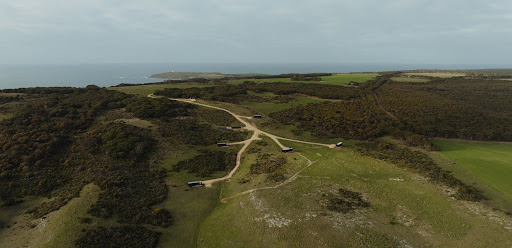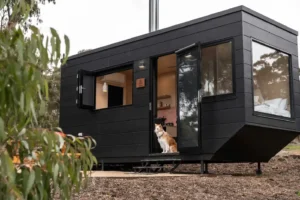When most people think of Kangaroo Island, they picture rugged cliffs, sleepy sea lions, and endless stretches of eucalyptus-dotted wilderness. But beneath the beauty lies something older – a story thousands of years in the making. A story that shaped South Australia before Adelaide even existed. And one that continues to shape the land today.
The history of Kangaroo Island is one where early farming settlements and dozens of shipwrecks in the 1800s meet with the untamed wilderness. So before you book a stay at a Kangaroo Island eco CABN, take a moment to walk through time. This is a travel guide and rediscovery of the people, myths, and milestones that gave the island its identity. Knowing the history of Kangaroo Island helps you see the land not just as a destination, but as a living museum shaped by time, sea, and story.
Indigenous History of Kangaroo Island
First, why was it once called the Island of the Dead?
Long before Captain Matthew Flinders arrived, Kangaroo Island had been home to Aboriginal people for over 16,000 years. Archaeological finds of animal bones, stone tools, and hearths suggest an extensive Indigenous occupation. These early inhabitants lived off the coastlines, hunting marine life and using native flora for food and medicine.
But around 10,000 years ago, rising sea levels separated the island from mainland South Australia, cutting off the Aboriginal population completely. Over generations, isolation left the land uninhabited.
To mainland Aboriginal communities like the Kaurna and Narungga, this empty land became known as Karta, or the “Island of the Dead.” Oral traditions passed down by Aboriginal women and Elders recount that spirits of the dead traveled to Karta after death. This sacred naming gives Kangaroo Island a haunting spiritual significance rarely explored in tourist brochures.
The Arrival of Captain Matthew Flinders
So, who gave Kangaroo Island its modern name?
In March 1802, Captain Matthew Flinders became the first European to set foot on the island during his circumnavigation of Australia aboard the HMS Investigator. After docking near Nepean Bay, Flinders and his crew encountered a landscape teeming with eastern grey kangaroos. Overjoyed after months without fresh meat, they hunted and feasted.
Flinders named the land “Kanguroo Island” to mark the abundance of these creatures. It was later adapted to the modern spelling we know today. His accounts became some of the earliest and most detailed records of the island’s flora, fauna, and coastline.
French Competition and Coastal Naming
Just months after Flinders’ visit, French explorer Nicolas Baudin arrived in January 1803. Though unaware of Flinders’ previous landing, Baudin’s crew conducted a comprehensive survey of the island. Many places still bear the names given by the French, including Cape St Albans, Vivonne Bay, and Hog Bay.
While Britain and France were bitter enemies at the time, their scientific missions in Encounter Bay were remarkably civil. They exchanged findings peacefully before continuing their voyages, making this a rare moment of diplomacy in colonial exploration.
The First European Settlement
In 1836, before the founding of Adelaide, the South Australian Government authorised the establishment of a free settled colony on Kangaroo Island. On 27 July that year, three ships – the Duke of York, Lady Mary Pelham, and John Pirie – arrived at Kingscote, making it the first colonial outpost in South Australia.
Settlers had high hopes. They believed the island’s fertile land, proximity to shipping lanes, and wildlife would support a thriving economy. Early industries included farmed sheep, barley, wheat, and eucalyptus oil distillation – a trade that remains part of the island’s economy today.
But isolation and poor planning made survival difficult. Many settlers later relocated to mainland South Australia, where Adelaide was founded later that year.
World War II and the Soldier Settlement Scheme
After World War II, the Soldier Settlement Scheme allocated farmland on Kangaroo Island to Australian veterans. With government support, many built new lives cultivating the land. While the scheme helped develop agricultural regions across the western end of the island, the challenging environment and limited infrastructure made success variable.
Still, this era left its mark on the island’s roads, land divisions, and farming communities, which continue to this day.
Shipwrecks and Maritime Mystery

The waters surrounding Kangaroo Island are notoriously treacherous. Since its first European settlement, more than 50 shipwrecks have occurred. The most famous include the Loch Sloy in 1899 and the Portland Maru in 1935.
Lighthouses like Cape Willoughby Lighthouse and beacons along Spencer Gulf and Gulf St Vincent now help prevent maritime disasters, but the island’s coastline still reminds visitors of the high human cost of exploration and settlement.
Jean M. Nunn and the Written History
Author Jean M. Nunn is a name not many visitors know, but her work “This Southern Land: A Social History of Kangaroo Island” is a foundational text. Her writings capture first-hand stories, settler challenges, and Indigenous references rarely documented elsewhere. Her work remains a key resource for those seeking a deeper look at the natural history and human impact on the island.
Kangaroo Island Today
Today, Kangaroo Island is an icon of conservation and nature-based tourism in South Australia. With protected areas like Flinders Chase National Park, Rocky River, and American River, the island attracts visitors from around the world.
Staying in a Kangaroo Island eco lodge like CABN offers travellers a rare chance to immerse in untouched wilderness while staying off-grid. Unlike larger developments, CABN’s nature cabins blend sustainability with design, offering a way to experience the island’s rich past and present with minimal impact.
Frequently Asked Questions
Why is Kangaroo Island called the Island of the Dead in Australia?
Mainland Aboriginal groups such as the Kaurna called it “Karta,” which means “Island of the Dead.” They believed the spirits of deceased ancestors travelled there, giving the island spiritual significance long before European arrival.
Why is Kangaroo Island so famous?
It’s famous for its unique wildlife, dramatic coastlines, and conservation efforts. The history of Kangaroo Island, including its early colonial role and Indigenous connections, adds cultural depth to its natural appeal.
What is the myth of Kangaroo Island?
Many Aboriginal stories surround the island, especially involving ancestral spirits. The idea of it being uninhabited for millennia after being cut off by rising sea levels contributes to its mythic status as a sacred and ghostly place; hence, the name, Island of the Dead.
Why is Kangaroo Island called Kangaroo Island?
Captain Matthew Flinders named it in 1802 after his crew encountered and hunted large numbers of kangaroos, providing them with fresh meat after months at sea.
How important is Kangaroo Island to South Australian history?
Kangaroo Island was pivotal to the early foundation of the state. It was South Australia’s first European settlement and played a key role in early colonial agriculture, maritime trade, and conservation.
Final Thoughts
Understanding the history of Kangaroo Island changes how you experience it. Every eucalyptus tree, every lighthouse, every sandy trail holds a story of the past, from the spirits of Aboriginal women to the determined hands of soldier settlers, and the scientific minds of Flinders and Baudin.
And when you stay with CABN, you’re slowing down, connecting to the land, and becoming part of a deeper story.



